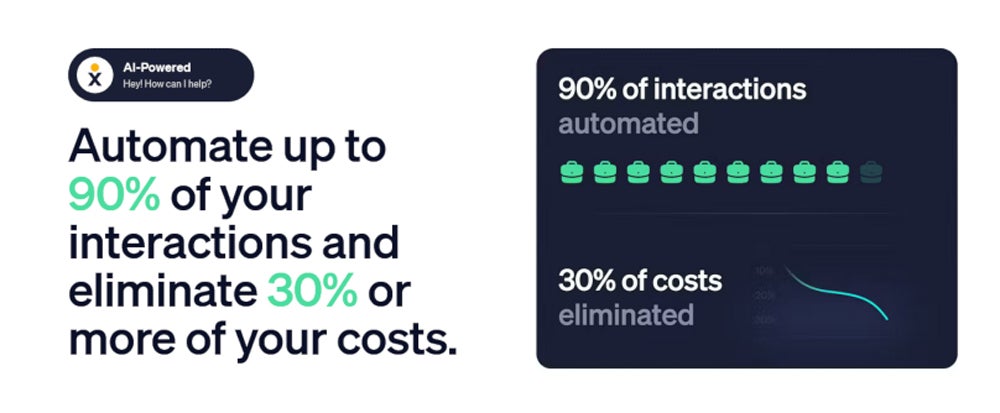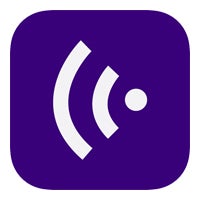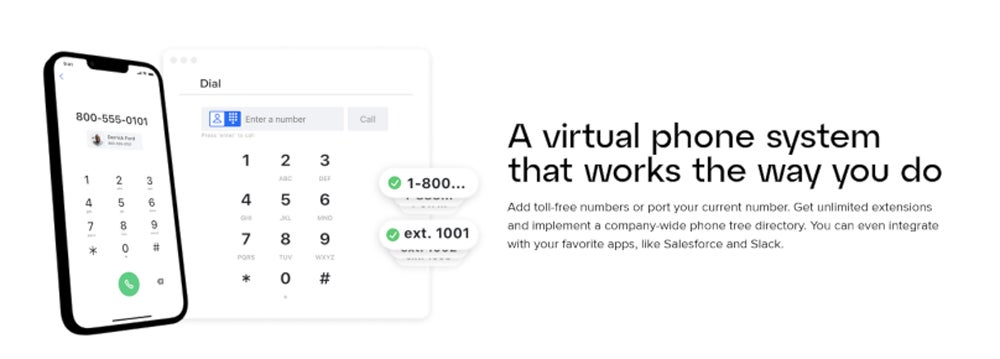In the process of searching for the best IVR solutions, I took a deep dive to learn how each feature works, what makes an overall system great, red flags to look out for, and the optimal use cases for all the major options on the market. This guide will walk you through my top six picks and provide you with the information you need to select the right interactive voice response software for your business.
You can’t buy IVR systems on their own–they come as part of business communications software. So, it’s best to take a step back and consider your overall needs. The table below covers some of the most important factors to look at when making your purchasing decision.
| Nextiva | ||||||
| RingCentral | ||||||
| Ooma | ||||||
| KrispCall | ||||||
| GoTo Connect | ||||||
| Aircall |
With a range of simple to advanced IVR functions, Nextiva is a great choice for businesses of all sizes. Smaller teams with tighter budgets can leverage its simple auto attendant features while enterprises and call centers can upgrade for full IVR capabilities.
Every Nextiva phone plan includes an auto attendant. The second tier and higher include multi-level auto attendants and a call flow builder, making it an affordable way to add basic IVR functionality for small or midsize teams. If you need more features, you can upgrade to Nextiva’s powerful all-in-one contact center solution for full IVR capabilities.
For more details, read my Nextiva vs RingCentral review.
Nextiva’s entry-level Essential plan includes a single-level auto attendant. You’ll need to upgrade to the Professional plan or higher for multi-level capabilities and the call flow editor.
For call centers needing advanced IVR capabilities, plans start at $129 per user per month.

| Pros | Cons |
|---|---|
|
|

Where Nextiva is simple and streamlined, RingCentral offers advanced capabilities at a lower price point. Unlike Nextiva, you can use the full extent of RingCentral’s IVR on every plan, including its cheapest phone system.
RingCentral’s advanced features, extensive integrations, and nearly infinite scalability make it a great choice for growing midsize and large businesses with complex needs. With an intuitive drag-and-drop interface, you can easily build as many IVR menus as you need. They can be as complex or as simple as you’d like, with nearly no limitations.
Month-to-month pricing is a bit more, but there are volume discounts once you reach more than 100 users. You can also upgrade to RingCX or RingCentral Contact Center starting at $65 per agent per month if you need more.

| Pros | Cons |
|---|---|
|
|

If you need to outfit a traditional office environment with desk phones and leverage basic IVR capabilities to route callers, Ooma can’t be beat. Ooma’s easy DIY, plug-and-play setup makes it a great choice, even if you don’t have IT pros on staff. The whole setup is so easy, it usually takes less than an hour.
Every Ooma plan includes its virtual receptionist, which lets you set up phone trees, record greetings, and route callers to the right people. You’ll be able to record general information about your business to help callers answer their own questions, route calls to specific ring groups, and even create special menus that occur during and after business hours. Like everything else with Ooma, setting up your virtual receptionist is easy with an intuitive builder that walks you through every step.
Ooma’s virtual receptionist is available on all three plans. While the entry-level tier is simple and straightforward, the middle and top tiers include team collaboration features, like text messaging, video conferencing, and team chat.
I appreciate that they give you the option of a barebones phone system if you want one.

| Pros | Cons |
|---|---|
|
|

Every IVR system I’ve covered so far includes unlimited calling. For infrequent or variable call volumes, it may not be worth it to pay higher monthly fees in exchange for no usage fees. Enter KrispCall, an affordable alternative for small businesses that don’t make or receive a lot of calls. Despite a monthly rate at nearly (or less than) half the price of the others, you get all the same functionality.
Full IVR, text messaging, softphone capabilities, ring groups, integrations, team chat, and analytics are all standard, no matter the plan you choose. You truly don’t have to miss out on advanced capabilities just because you can’t justify paying for unlimited calling. Plus, you can purchase local phone numbers in more than 100 countries, making it easy for your small business to have the appearance of a much larger organization.
IVR is included with every plan. However, you will have to pay per minute for calls and per message for texts. For US-based calls, usage rates start at $0.0197 per minute for inbound and $0.02 for outbound calls. Usage rates vary depending on the country you’re calling.

| Pros | Cons |
|---|---|
|
|

GoTo Connect doesn’t have the most integrations on my list. But it does have some of the deepest and most useful integrations with popular CRMs, collaboration tools, marketing automation suites, and customer service software. Plus, its IVR, smart call routing, and customizable dial features are included with every plan.
Not only will you be able to create menus to route callers to the right place, you can also set up automations based on time, day of the week, your holiday calendar, or anything else that alters your call flows. And if you need more power, you can easily upgrade to access contact center capabilities.
GoTo Connect’s pricing is based on a custom quote. However, all four plans include IVR and automated call routing capabilities.

| Pros | Cons |
|---|---|
|
|

If usability and a clean, modern interface are important to you, Aircall is worth a closer look. Its interface is my favorite of all the solutions on this list. As a cloud-first alternative to communication giants, like Nextiva and RingCentral, its usability is second to none.
Creating complex IVR menus is streamlined with a visual rules-based editor. Plus, you can build them regardless of the plan you choose. You can add as many levels as you need, customize for different times of day, optimize around peak hours, and reduce your capacity during slower times.
Aircall offers two standard plans and a custom plan, depending on what you need. All of them include full IVR capabilities, unlimited calling within the US and Canada, text messaging, and unlimited simultaneous outbound calls. Overall, Aircall is a bit more expensive than most of the other options. However, it offers unmatched value at this price point.

| Pros | Cons |
|---|---|
|
|
An IVR system isn’t something you’ll get on its own–it exists within full phone systems and contact center solutions. So, you need to consider the entire function as a whole when making your decision.
The best thing you can do is make a shortlist of suitable options and sign up for free trials or demos.
I recommend paying close attention to customer service, integrations, implementation, the user interface, scalability, and customization options. These are some of the biggest differentiators between business phone systems–the right balance for you depends on what you need.
From there, you can test your top contenders with other members of your team to make sure there aren’t any concerns before you purchase and roll it out across your business.
When putting this guide together, I prioritized customer feedback, case studies, user reviews, and my own experiences for a holistic look at each option.
The following factors played a major role in selecting my top picks:
I looked at hundreds of reviews for each solution, prioritizing those with happy customers.
Since IVR is one part of communications systems, I looked for providers that include a wide range of adjacent features that enable you to make the most of it.
I looked for providers that presented clear and straightforward pricing information so that businesses would have no problem understanding the investment.
I considered how well each IVR provider integrates with existing business systems, aiming for minimal disruption during implementation.
I assessed each provider’s ability to scale alongside a business’s growing needs, ensuring adaptability to changing demands.